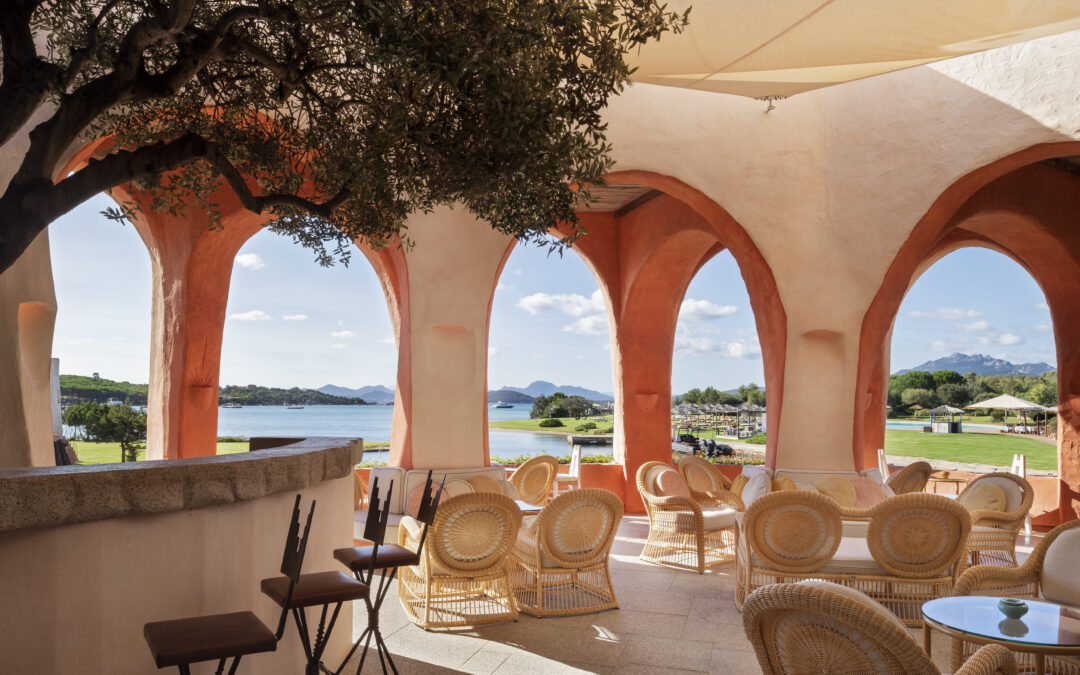A hotspot in the 60s and 70s, adored by Prince Karim Aga Khan, it was a mythical meeting place for the jet-set. James Bond even stopped there in The Spy Who Loved Me. The interior design agency Moinard Bétaille has completed a sensitive and poetic renovation of the hotel Cala di Volpe (Sardinia), brilliantly reviving the monumental work of the French architect.
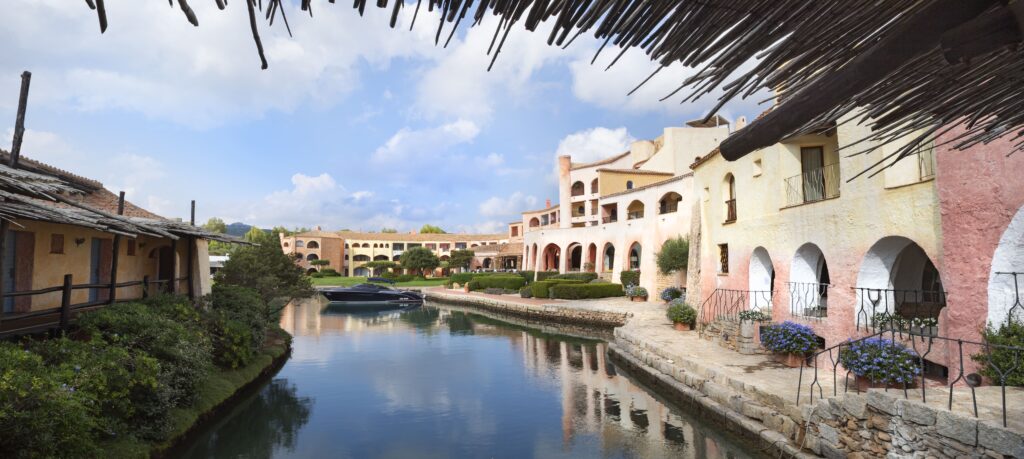
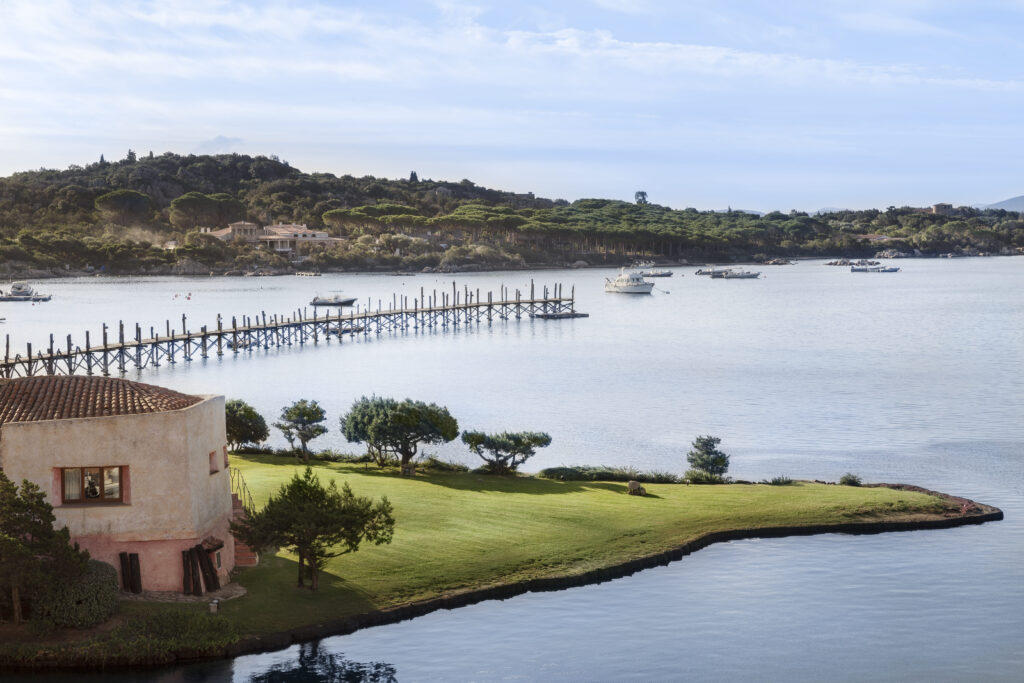
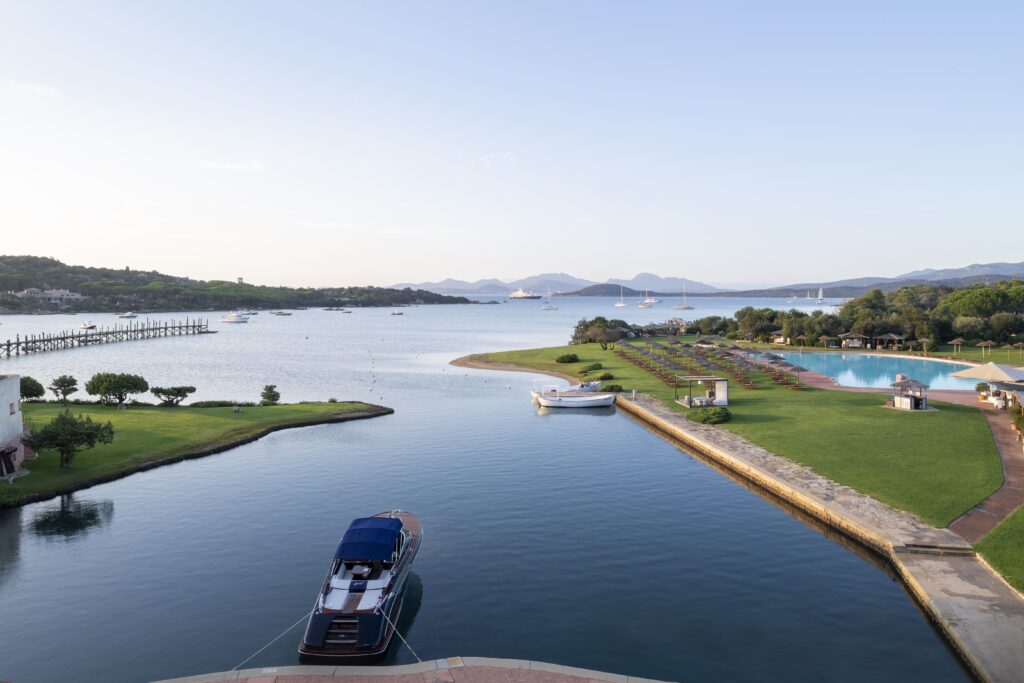
Bruno Moinard and Claire Bétaille, experienced in the art of the revival of prestigious hotels (Plaza Athénée in Paris, Four Seasons Trinity Square in London, Eden in Rome), have cast their singular gaze on this habitable work of art that needed to be rethought and relit, while respecting the original creative action of Couëlle.
After four years of work, the mythical Cala di Volpe hotel, on the Costa Smeralda, in Sardinia, welcomes its visitors with more brilliance than ever. It is the symbol of the creative genius of Jacques Couëlle, the great architect who invented the ‘sculpture-houses’, which appear raw and buried in their environment but are extremely refined in form. Intimately associating nature and simple luxury, it perfectly corresponds to our time and its aspirations.
They wanted to keep the soul of the place intact, and loved adapting to the empire of materials reigning supreme here: the powerfully sculpted plaster which reserves havens of freshness, the barely civilsed wood which punctuates the structures and visual effect, the thick glass in colour compositions that filters the unique light of the bay, the warm silky terracotta underfoot, the skilfully reinvented fabrics. The furniture, for the most part, was custom-designed and often mobilised local know-how.
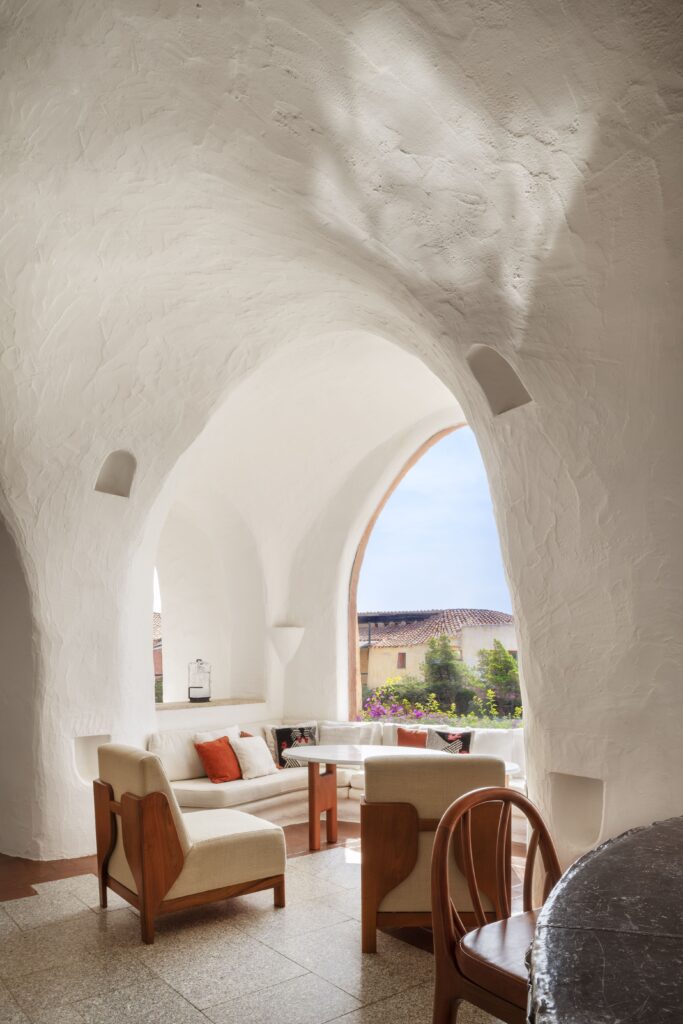
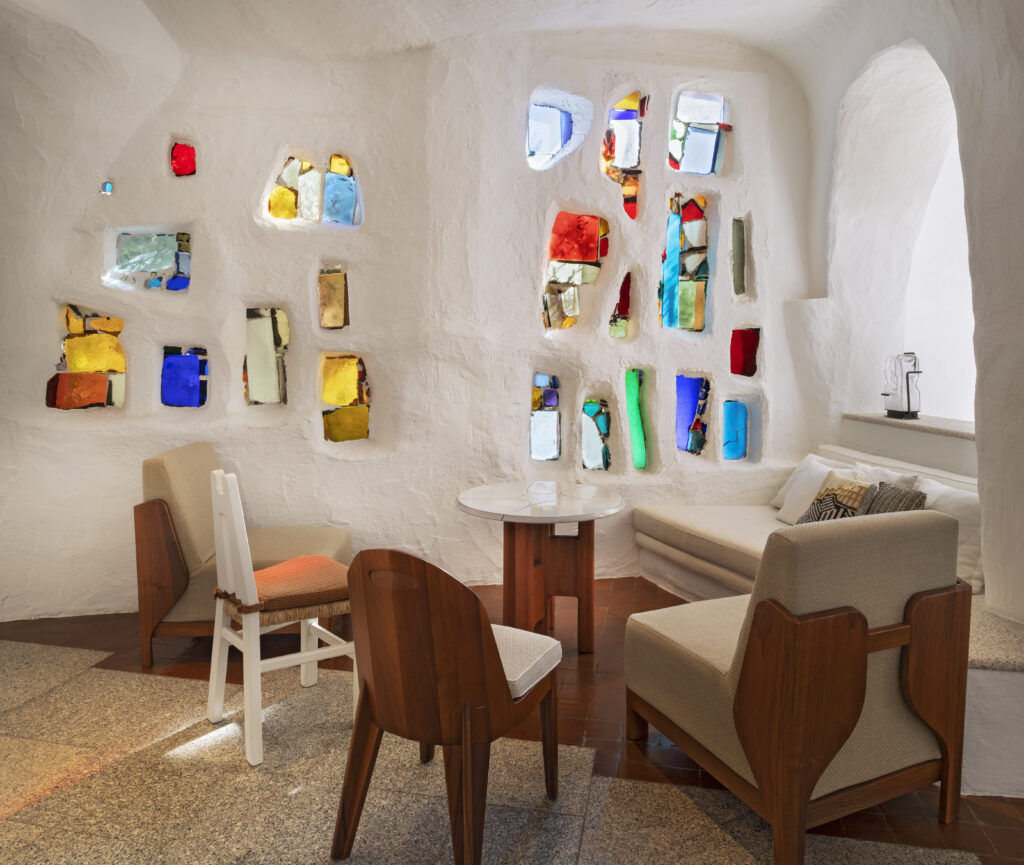
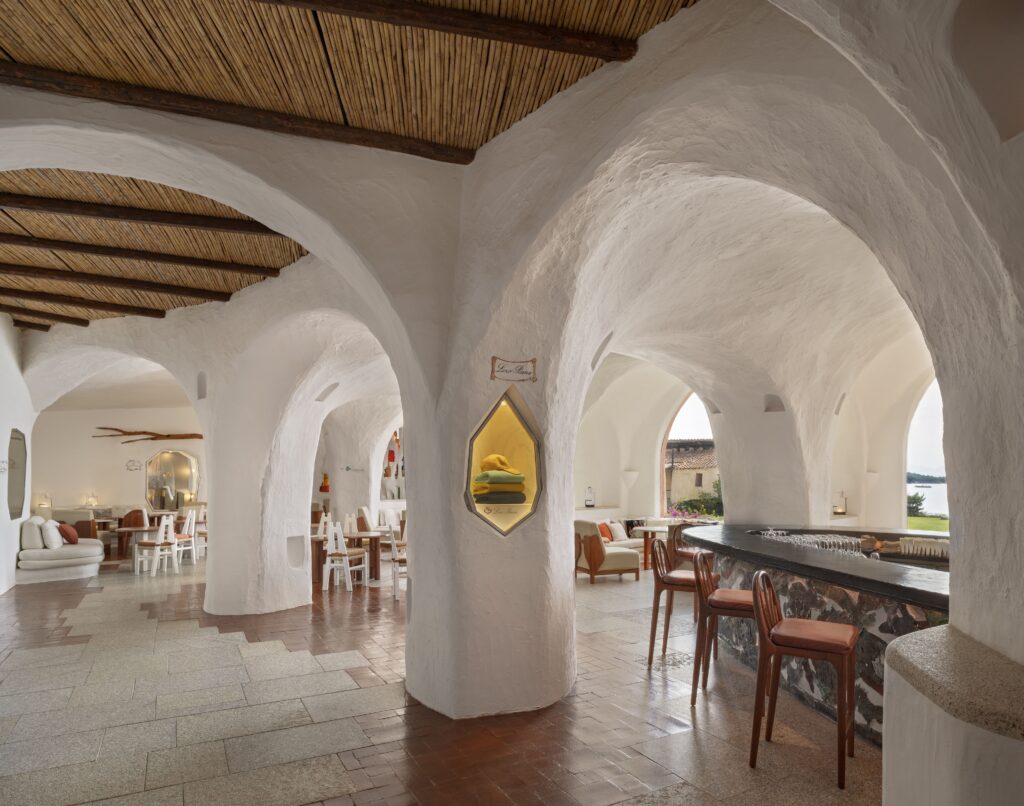
From the lobby to the rooms and suites, from the terraces overlooking the sea to the two restaurants (Le Grand and the Beefbar), Bruno Moinard and Claire Bétaille have restored the luster to the most flamboyant hotel in Sardinia. Revived by the travelling architects, the Cala di Volpe experience, simple and refined, is to be discovered and retold.
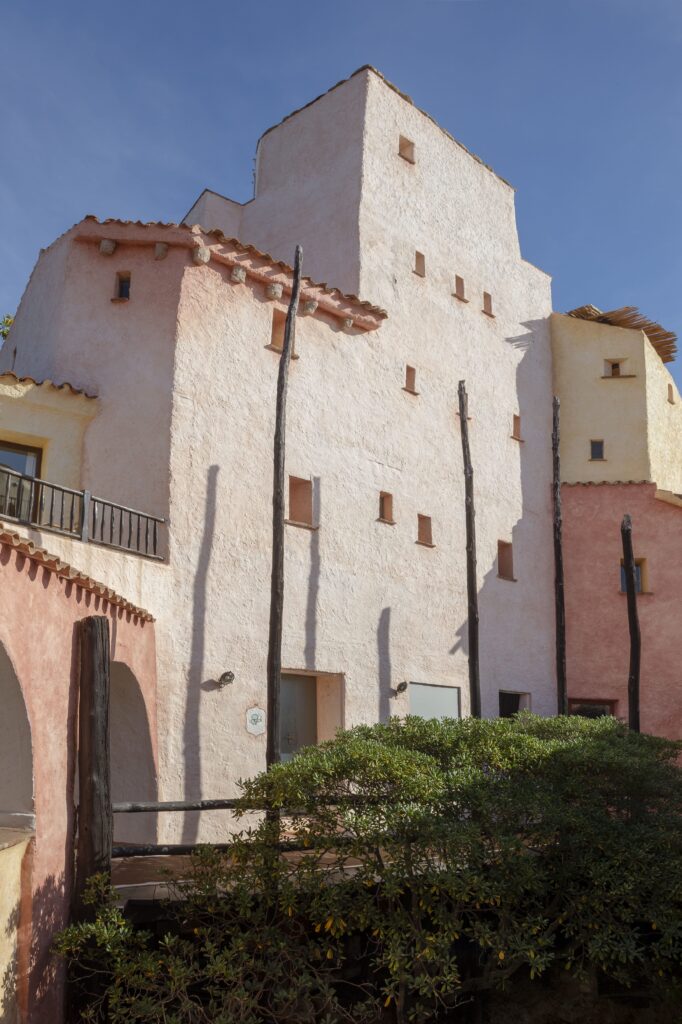
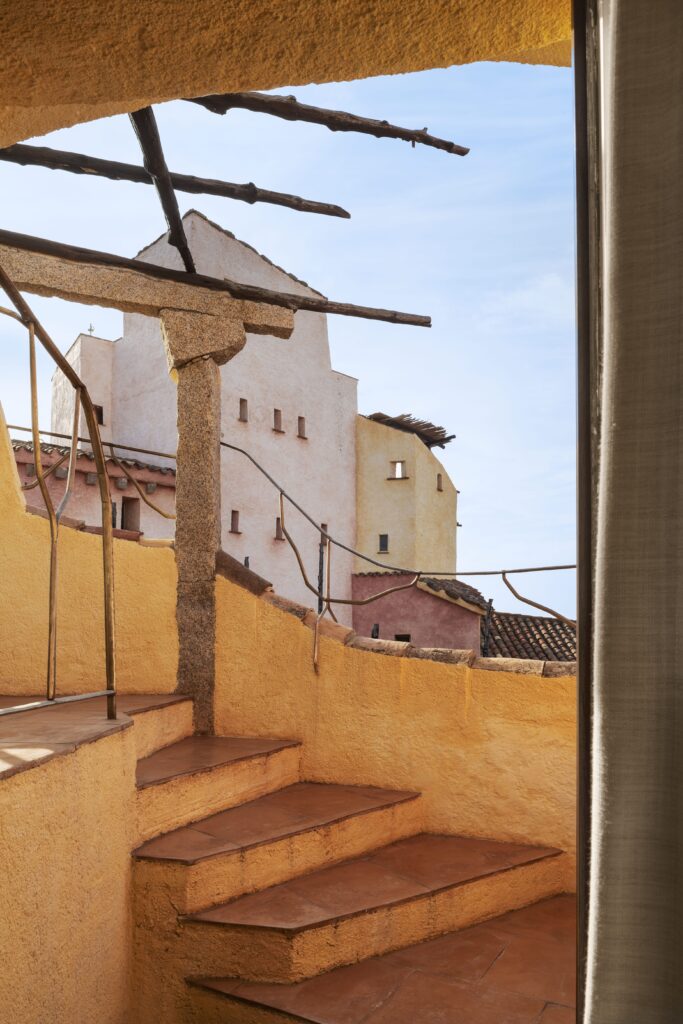
The Exciting Mission During The Renovation Of Hotel Cala Di Volpe: Interview With Bruno Moinard And Claire Bétaille
Cala Di Volpe is the indestructible alliance of the will of the artist and the demands of nature. – Bruno Moinard
Your agency specialises in hotel refurbishment. In recent years, you’ve renovated the Plaza Athénée in Paris, the Four Seasons in London and the Hotel Eden in Rome. Each time, you put your stamp on it and yet, mutatis mutandis, the institutions entrusted to you seem never to have been so much themselves after your visit.
What attracts you to hotels and what are your convictions?
Bruno Moinard (b.m.): As you know, Claire and I are travelling architects, and hotels are our points of attachment in the countries we visit. We feel them intimately. Hotels have a soul, each its own, and each has its own way of being inhabited. Each suite is unique, each bar is a piece of civilisation, and each lobby an introduction to a unique experience. Each hotel is a theatre, with its sets, its characters, its secrets and sometimes its intrigues.
Claire Bētaille (c.b.): We inherit these stories and we should allow hotels to continue to write them, never cutting the thread, but rather reviving them. We soak up these places, the way we consume them, the atmosphere, the stories we are told about them, and we change what needs to be changed to project the establishment into its own future. This involves the circulation, the work on the light, the promise of conviviality, the furniture, and of course the optimisation of comfort.
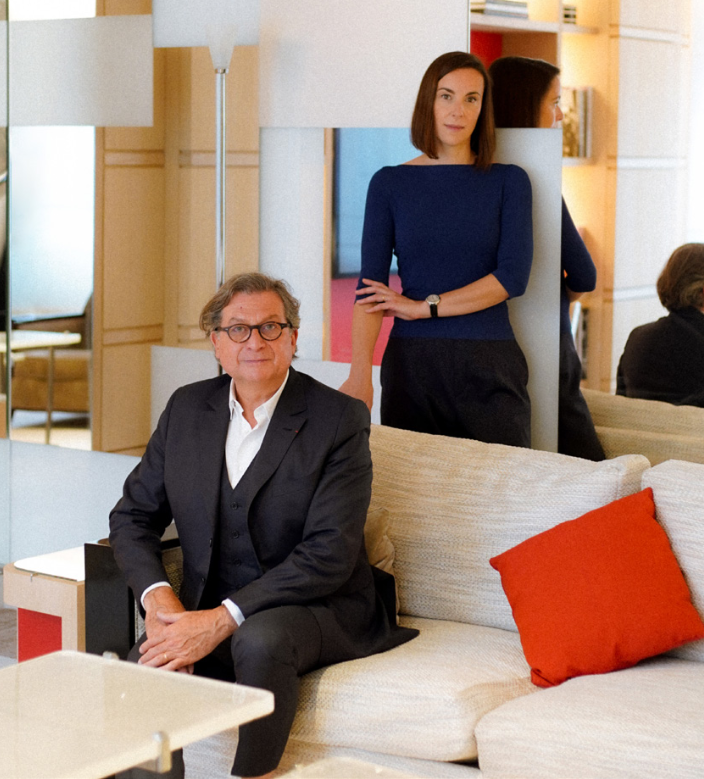
Four years ago, you began the renovation of the Cala di Volpe hotel, in Sardinia, on the Costa Smeralda. This hotel is itself a work of art, almost a sculpture. Can we touch a work of art, can we inhabit it?
b.m. Jacques Couëlle is an immense artist as well as being a great architect. The architecture-sculpture of which he was the standard-bearer in the 1960s and 1970s spoke to his era by the incredible modernity of his vision at the same time as by his celebration of nature. His landscape houses testify to this desire to reinterpret nature to better blend in with it. They were intended, from the beginning, to be inhabited. But, indeed, touching a work, if only by retouching it, involves a responsibility…
Cala di Volpe is the indestructible alliance of the will of the artist and the demands of nature. This need to return to the truth, to merge with a preserved environment, resurfaces in our lives: this hotel has never been so in tune with the aspirations of the moment. Cala di Volpe is harmony, surprise, peace: in a word, true luxury. Our ambition was to give this magical place back its luster, but also its function in today’s world.
Between the original core that came out of Jacques Couëlle’s head and the hotel as it had evol- ved over the decades, you had to work on a composite whole. Concretely, what was your course of action? How did you retain the soul of the place?
b.m. The envelope is intangible, just like the line, or the curve. It is a tribute to the interplay of cool shadow and bright light. We wanted to reexplore this maze, awaken the energies that were hiding there, make this living organism breathe again, and reinvent the circulation. And, you are right: the hotel had expanded, and colonised its surroundings. We have reconnected it to the vegetation and marine environment that embraces it, at the same time as to life today. Year after year, as the work progressed, we reunited the Cala di Volpe in a coherent hotel concept, speaking a single language, writing a single story.
The Moinard-Bétaille agency is renowned for its science and its love of materials. In the case of Cala di Volpe, where the material resembles a clay to be reworked, to be domesticated to give it a shape, you have been particularly pampered!
b.m. We have been, as Jacques Couëlle had been in his time, under the control of materials. The Cala di Volpe is powerfully built, inserted into a nature of which it is the extension. Here, it is the material that commands. However, both by reworking what already exists and by bringing in new elements, we were able to give free rein to our inspiration. We played with friendly stone, obedient plaster, rough-hewn yet so noble wood, thick stained glass, and punctured the walls with spiritual, colourful lights.
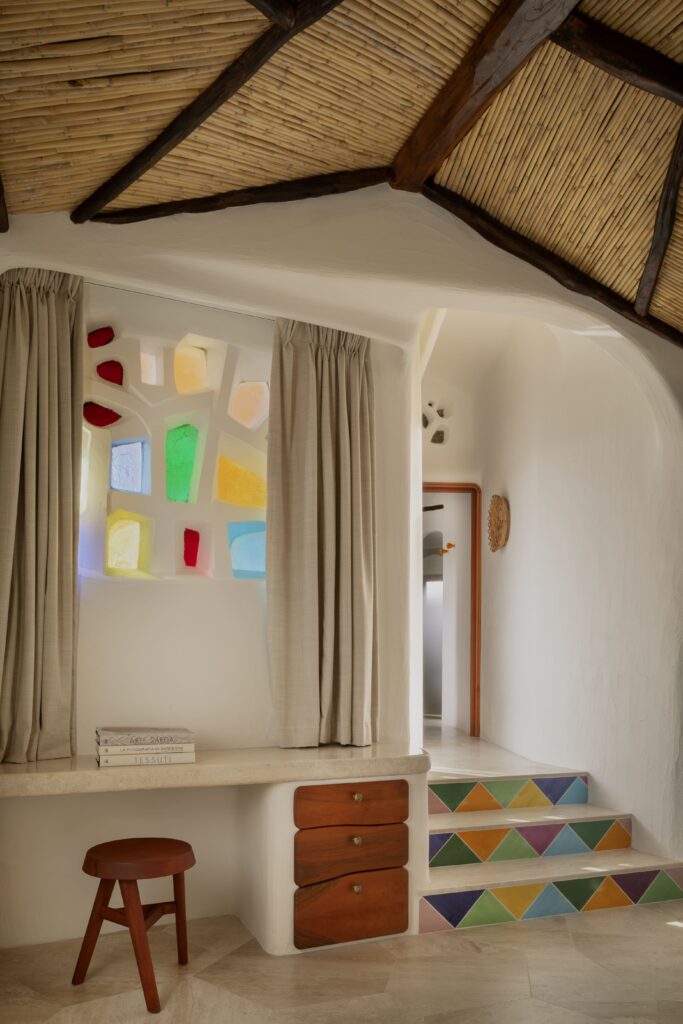
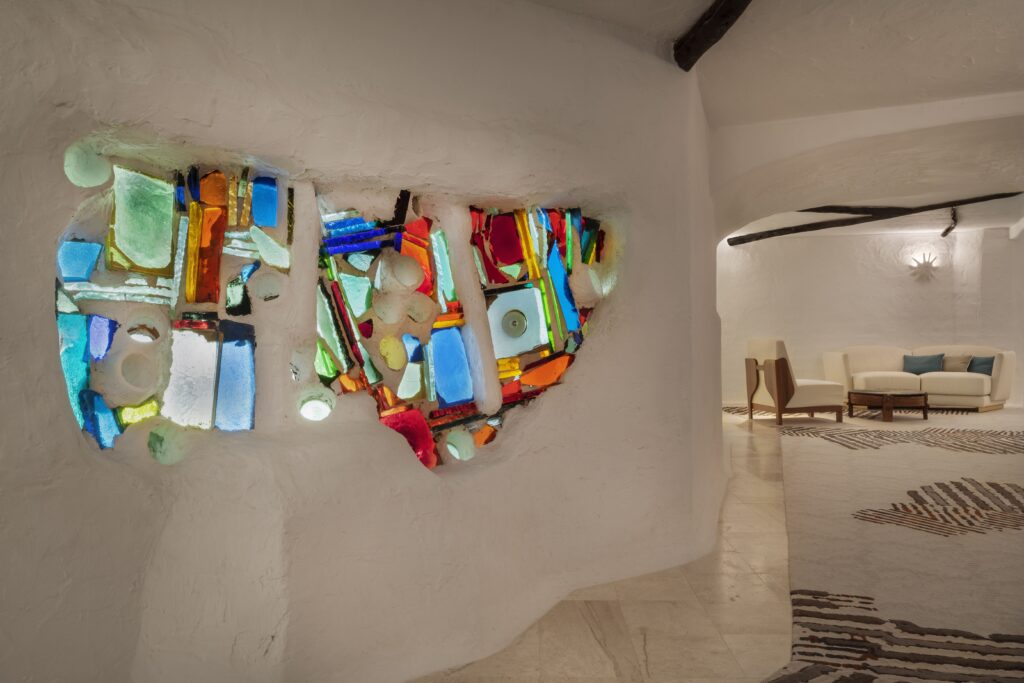
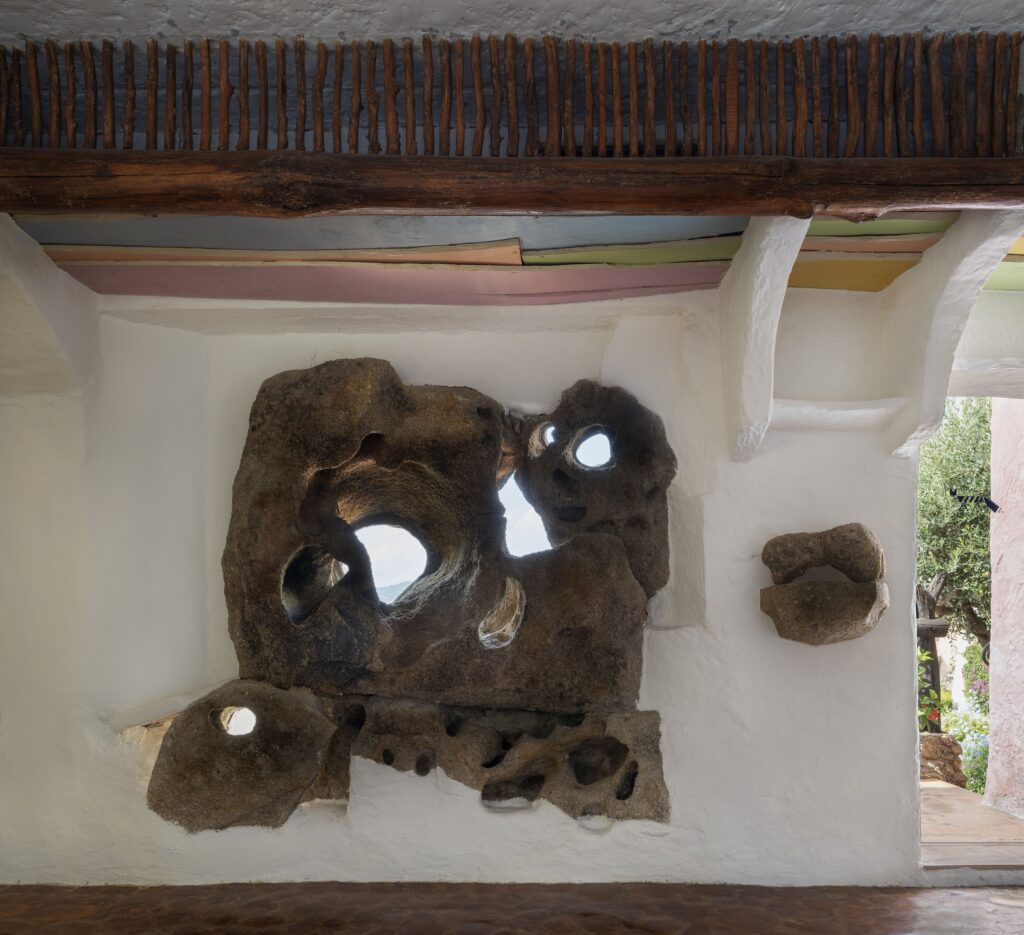
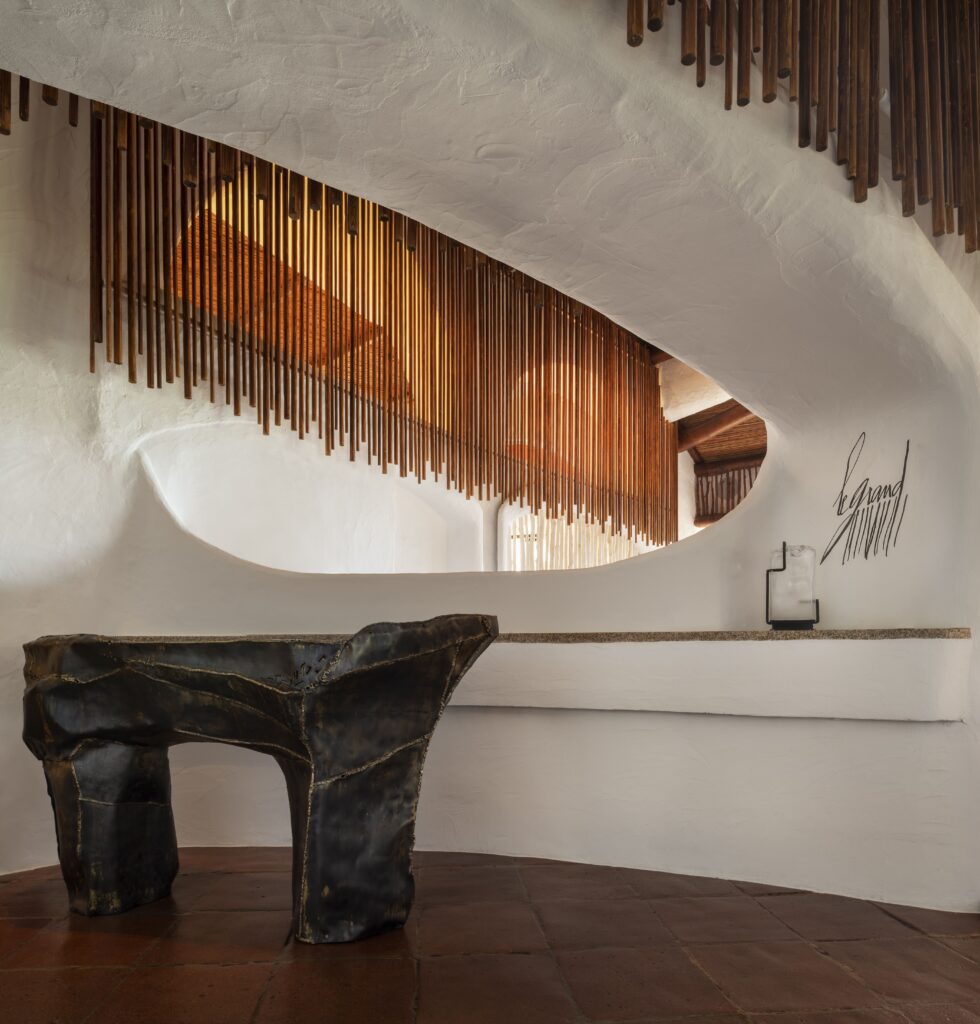
Organising the encounter between roughness, even softened, and extreme refinement. – Claire Bētaille
Talking about forms and materials means talking about the use that visitors have of places and the experience they have there. For the interior architects that you are, it is inevitably about design.
b.m. This was perhaps our biggest challenge. Namely, organising the encounter between roughness, even softened, and extreme refinement, in a contemporary vision. In the setting that is Cala di Volpe, the arcades, buttresses, hidden stairs, unexpected benches, and irregular layout of the floors, everything adds structure and makes sense. We wanted furniture that remained free, without artifice, that would be comfortable, warm, and which dialogued with the walls, and combined with the spaces and uneven openings in a timeless and singular synthesis.
Renovation Details: Notebook
The Lobby
Spectacular and singular, the hotel lobby has kept its structural elements: vaults, arcades, beams and massive pillars stay faithful to the place. The mood, the visual rhythm, the general impression: nothing has changed in appearance. And yet everything has been refreshed, renovated and rearranged. The lighting has been revised for more softness during the day and warmth in the evening. A full range of furniture has been created.
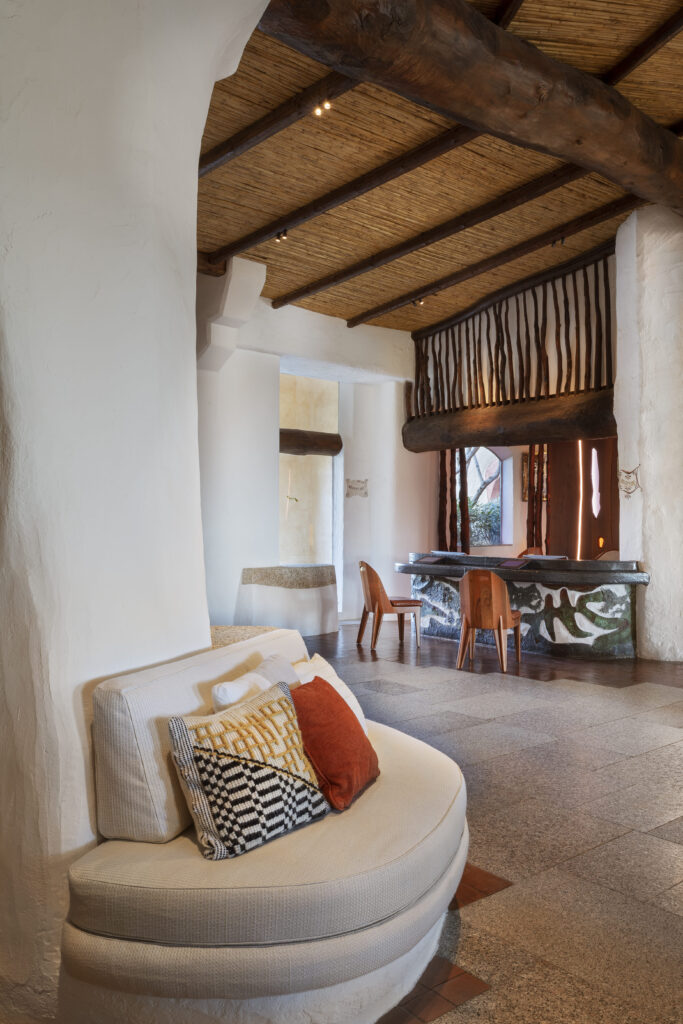
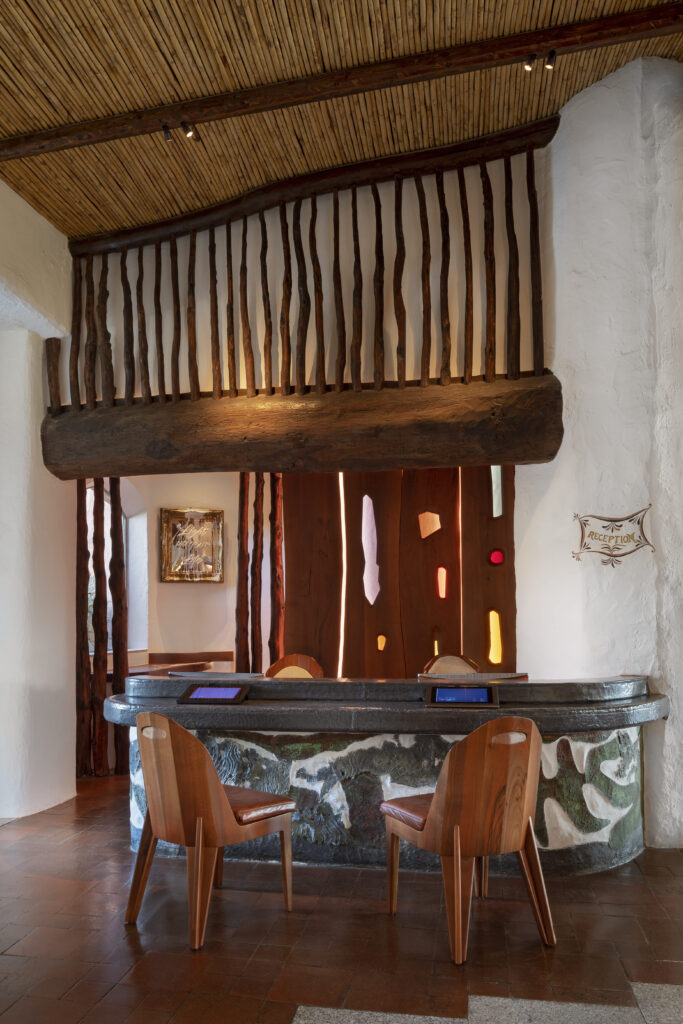
- The wave-shaped conciergerie has been retained, featuring a fresco cut out of oxidised copper. Echoing it, a reception designed on the same principle has been added, also adorned with copper and covered with lead.
- Life around the pillars has been reorganized, creating places of conviviality desired from the out- set, inviting conversation and relaxation.
- Sofas, benches and seats can be combined. They associate wood, weaving and fine leathers.
- Armchairs with paddle uprights, chairs with shaped backs, carved from solid walnut and upholstered in leather or cord, coexist with the small original seats present throughout the hotel, which have been given a new lease of life. The tables with bare wood legs associate with enameled lava trays.
- The work on the cushions was particularly advanced. In this setting of stone, glass, plaster and wood, they are symbols of comfort. Shapes, materials, colours have been multiplied, certain of which involved the Sardinian tapestry tradition known as a pibiones.
- The bar has more than doubled in size. It was designed on the same principle as the conciergerie, and oriented so that everyone can see the sea while refreshing themselves. The walnut stools with short, rounded backs respond to the soft shapes of the arches.
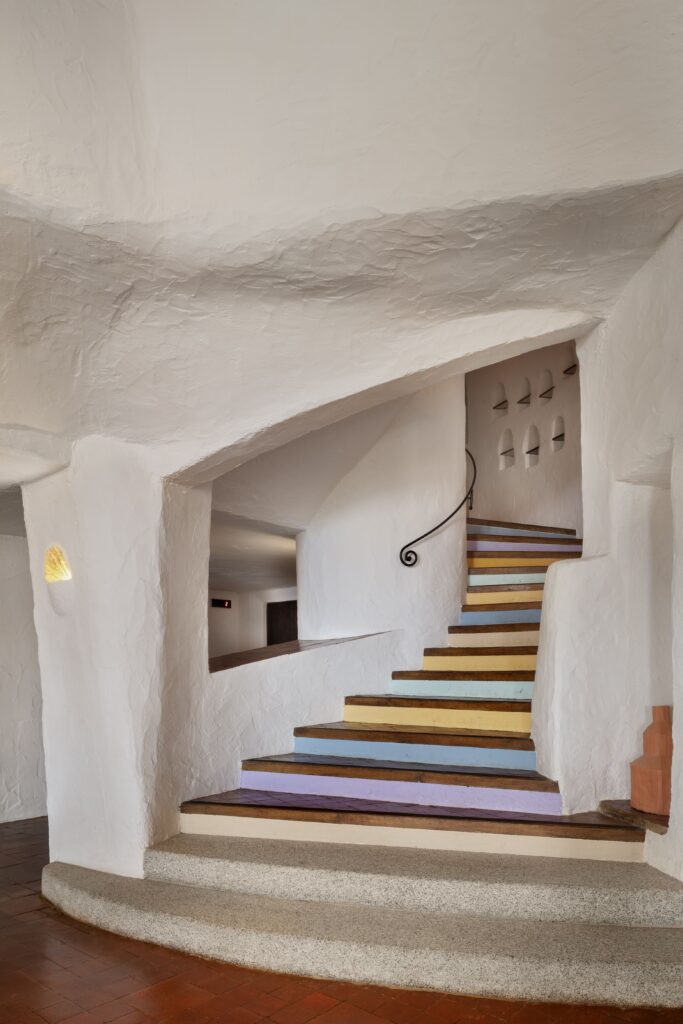
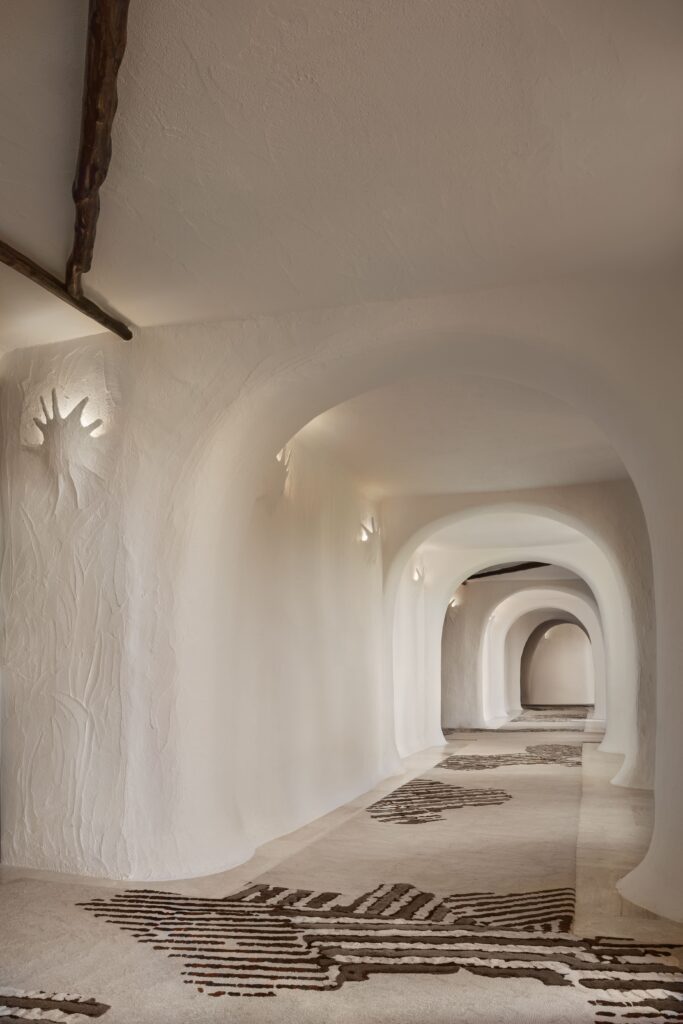
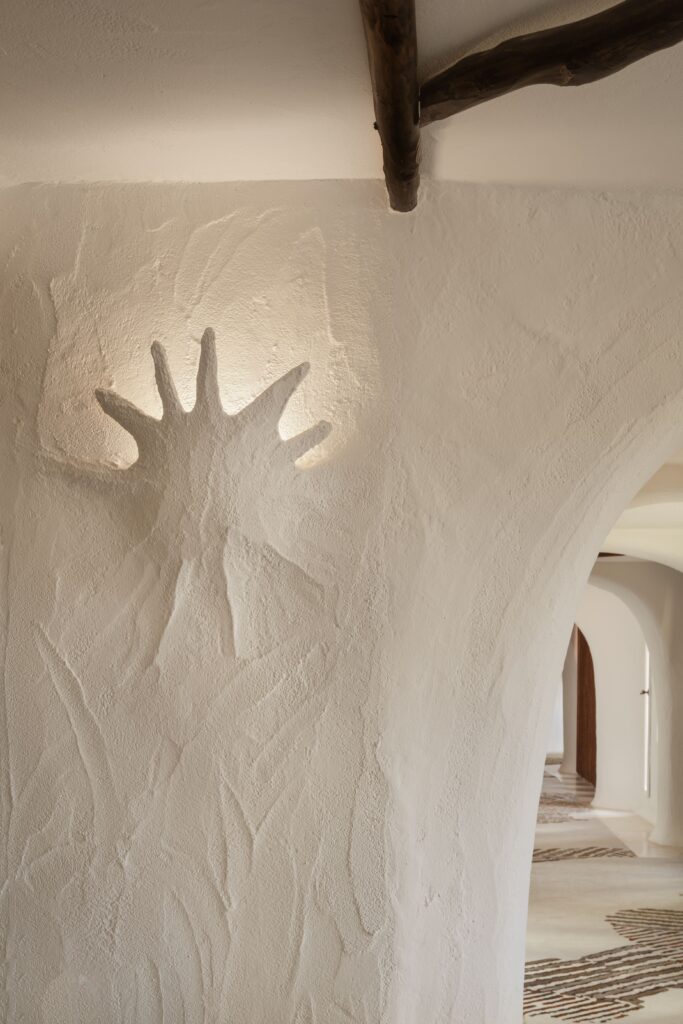
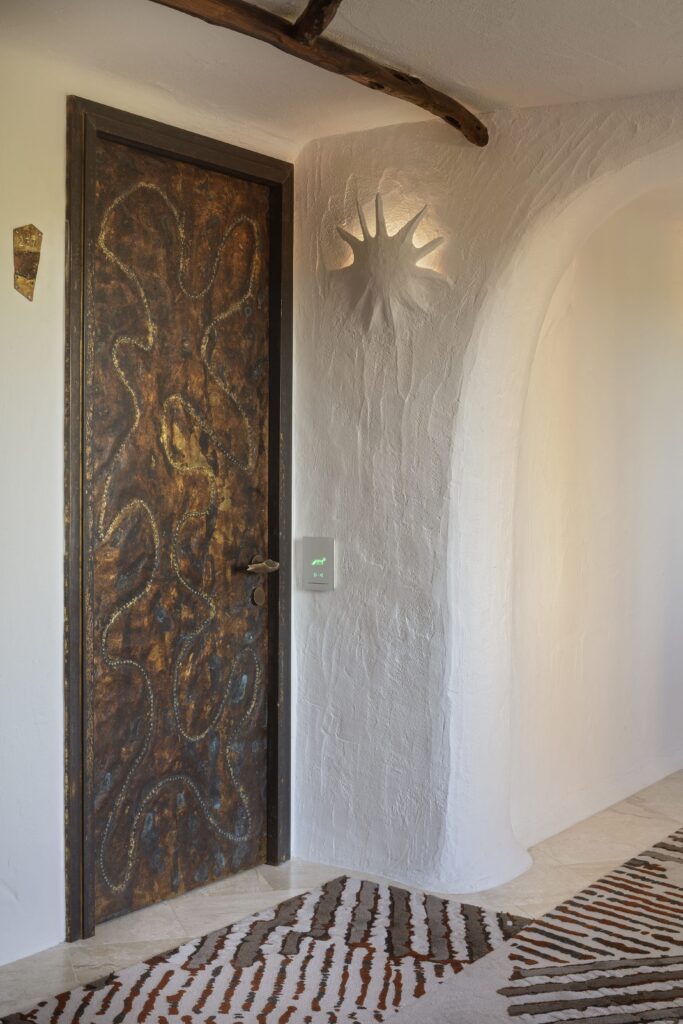
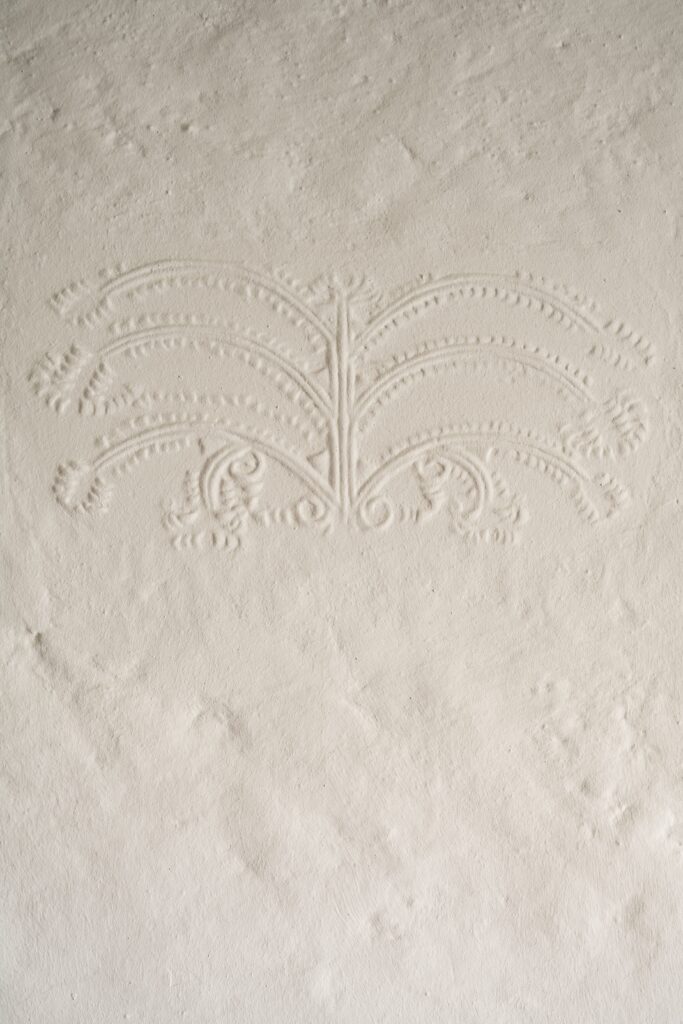
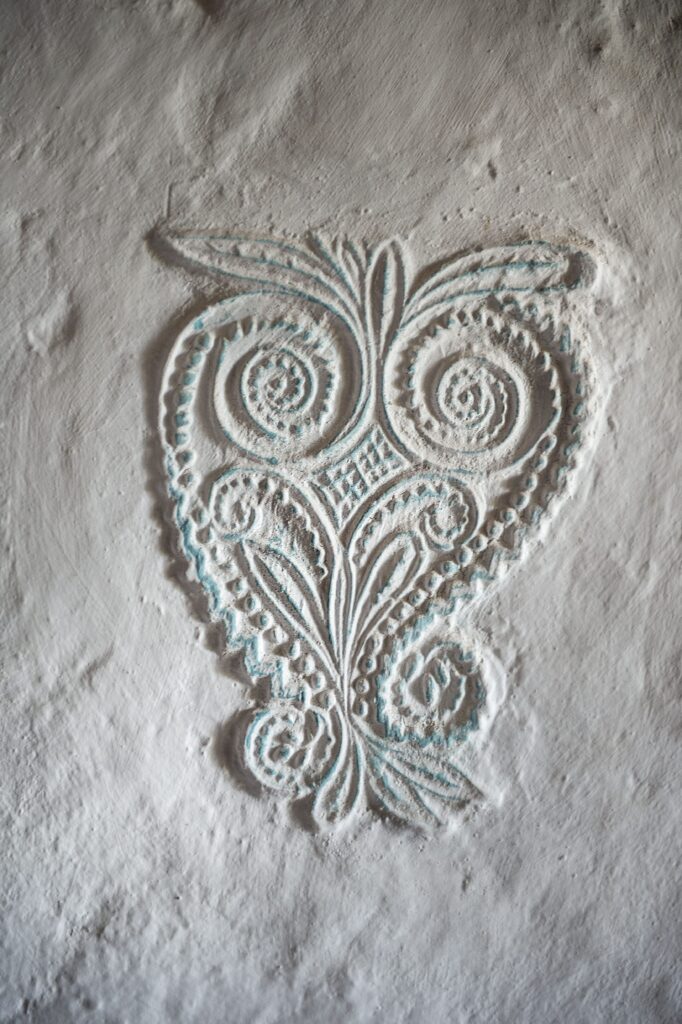
Corridors
As key elements of circulation in the hotel, and therefore of the experience while moving around, the corridors serving the rooms needed to be reorganised to be in unison with the common areas.
- The openings and windows have been covered with wooden bars, softening the light and creating, depending on the time of day, graphic shadows on the floor and on the walls.
- Spots of shadow, evoking those of trees, are found on the pavement, in irregular areas, thanks to the striped carpet concealing a scattering of little foxes, a mischievous reminder of the hotel logo.
The Rooms
Places of life, intimacy and peace, the rooms each offer a unique universe. However, a few constants and biases bring them together. Rounded corners and half partitions create a soft environment. The idea is that the light slides unhindered from one end of the space to the other.
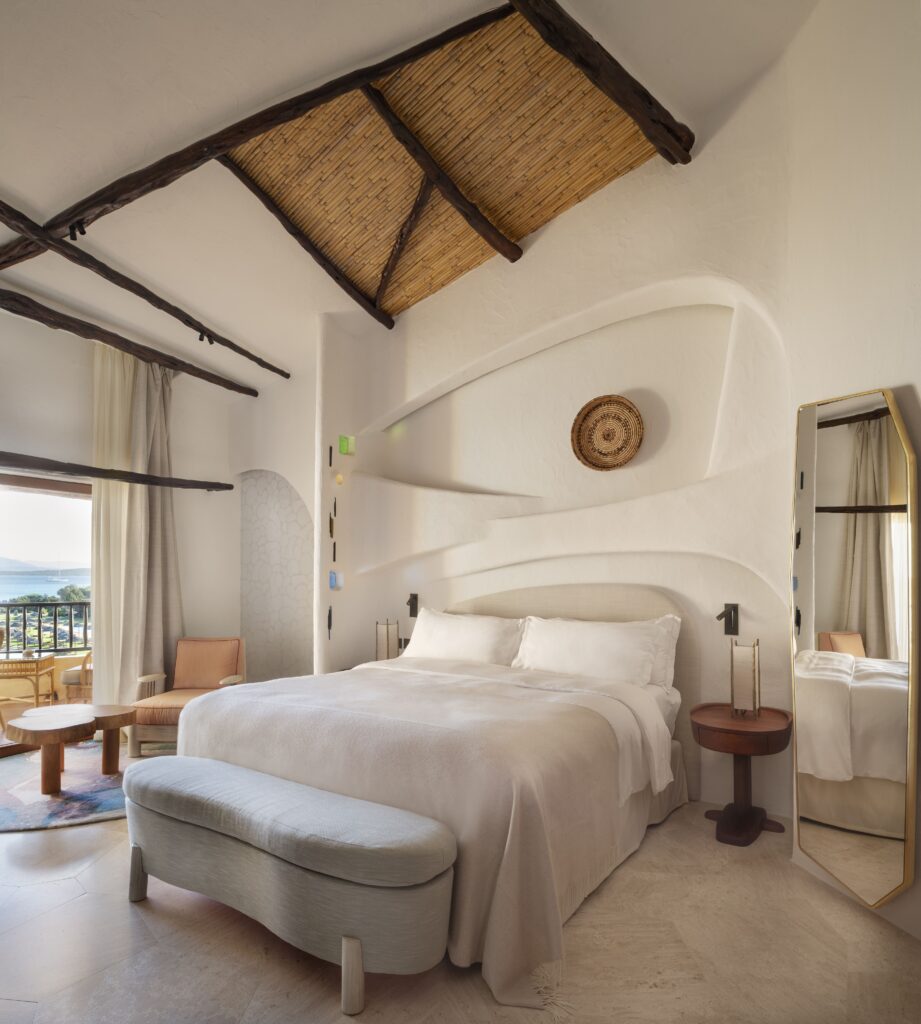
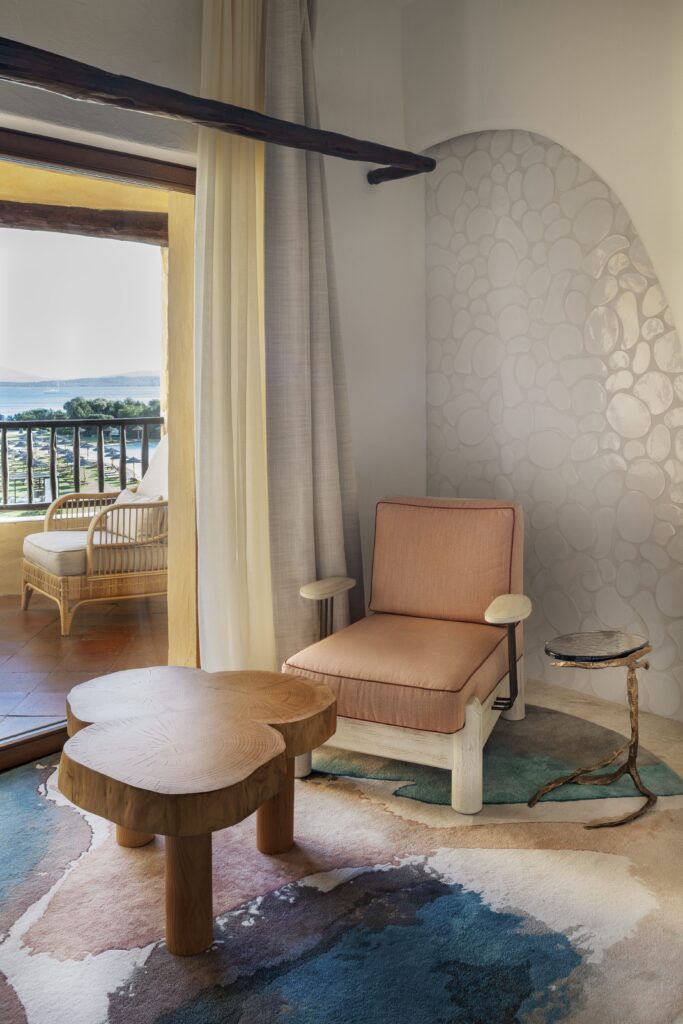
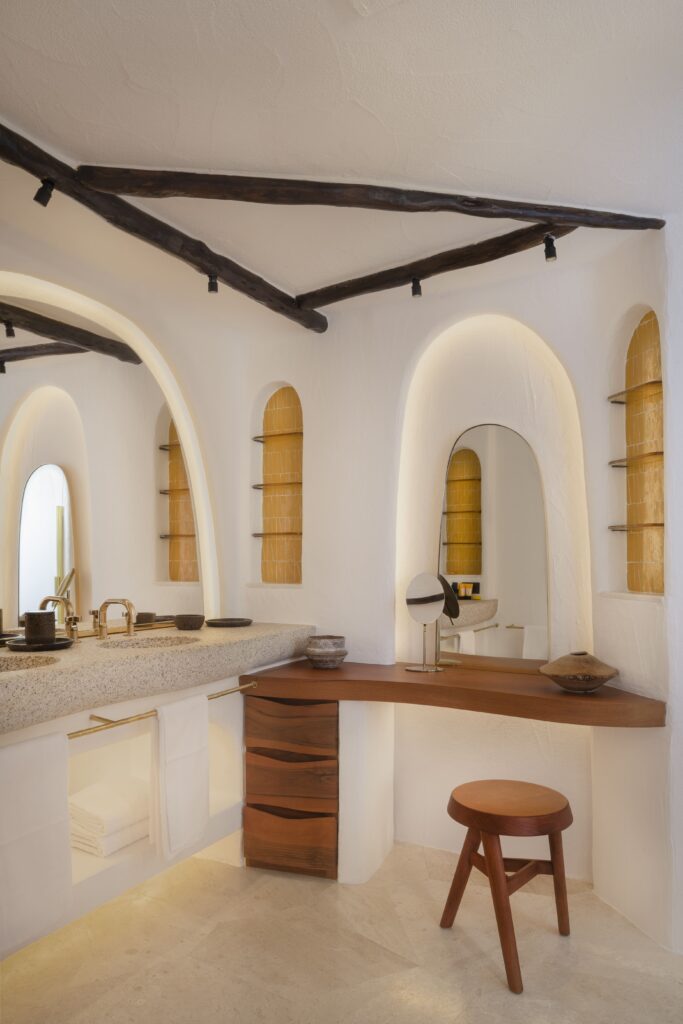
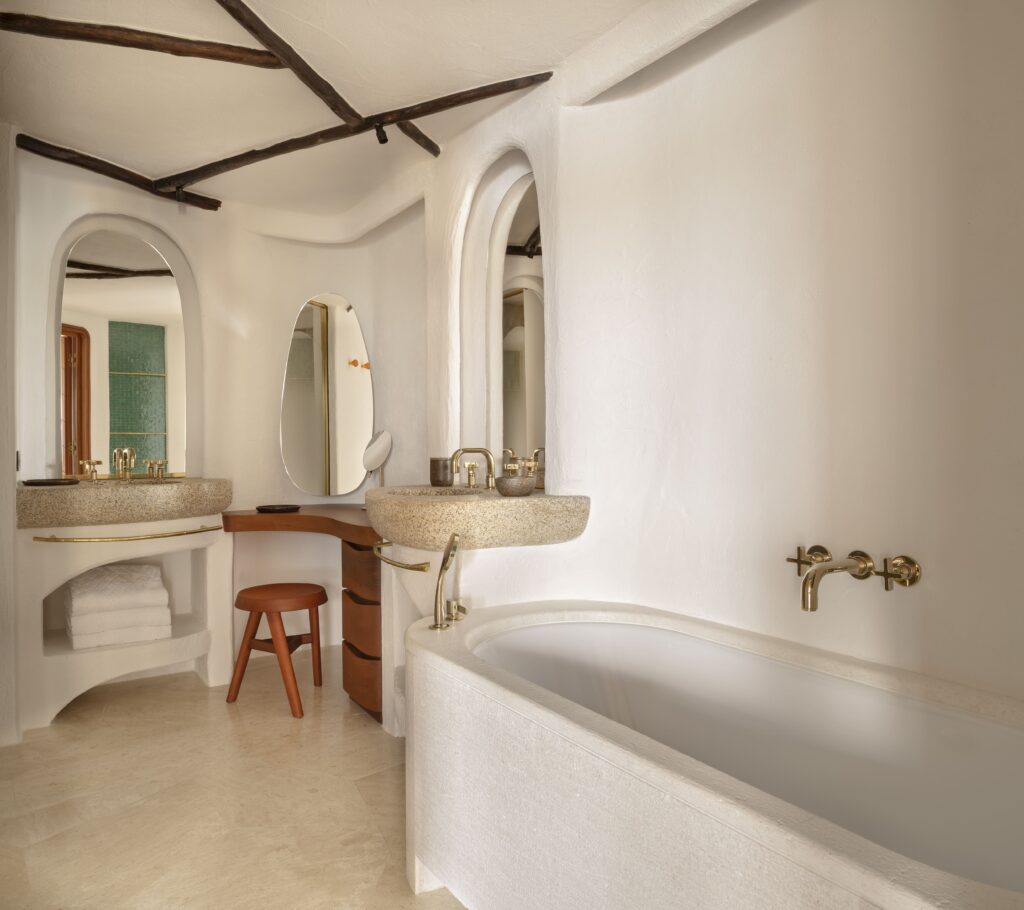
- The large beds topped with a canopy of reeds look out to sea.
- The dark, shiny juniper wood contrasts with the matt white masonry. It becomes a pillar, beam and bar, and structures the volume.
- Specific furniture has been designed: a chest of drawers rounded like a pebble in solid walnut with bronze feet; also in cast bronze, in the shape of seaweed, are these side tables with thick glass tops; fireside chairs and opulent sofas are arranged along the walls or extending from the beds; also console desks in stone, and tables in solid resinous wood. There is discreet wall or lamp lighting everywhere, like this creation superimposing Sardinian pottery.
- In the bathrooms, everything is as if polished by water: the (local) granite sinks hollowed or placed, the rounded mirrors reminiscent of the openings, surrounded by studied lighting. The shower and bath areas are covered with brightly coloured zellij tiles. And as a reminder, in some bathrooms, the large stained glass imposes its inspiring presence.
- The terraces are an extension of the rooms and suites. Each of them faces the sea. The rattan furniture has been specially designed for the hotel. It is made by one of the last expert Italian workshops in the material, the same ones that made the furniture when the hotel was created. The tabletop combines stone, enamel and glass creating landscapes reminiscent of the bay of Cala di Volpe…
- A warm and welcoming masonry bench echoes those in the lobby. The small armchairs designed by Jacques Couëlle, with their cord and leather cushions, have been reissued. Deep rattan furniture designed in partnership with Bonacina 1889, the last great Italian specialist, populates the space in a winter garden spirit. The plaited backrests radiate like the sun, and their curve follows that of the arches. Tables with a solid glass top complete the furnishings.
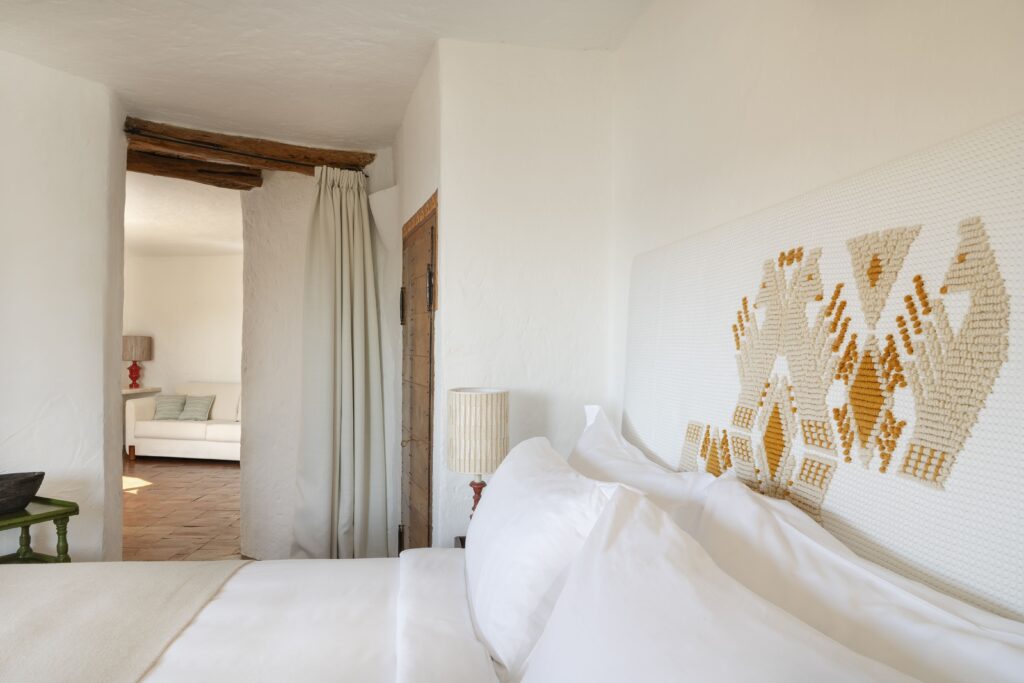
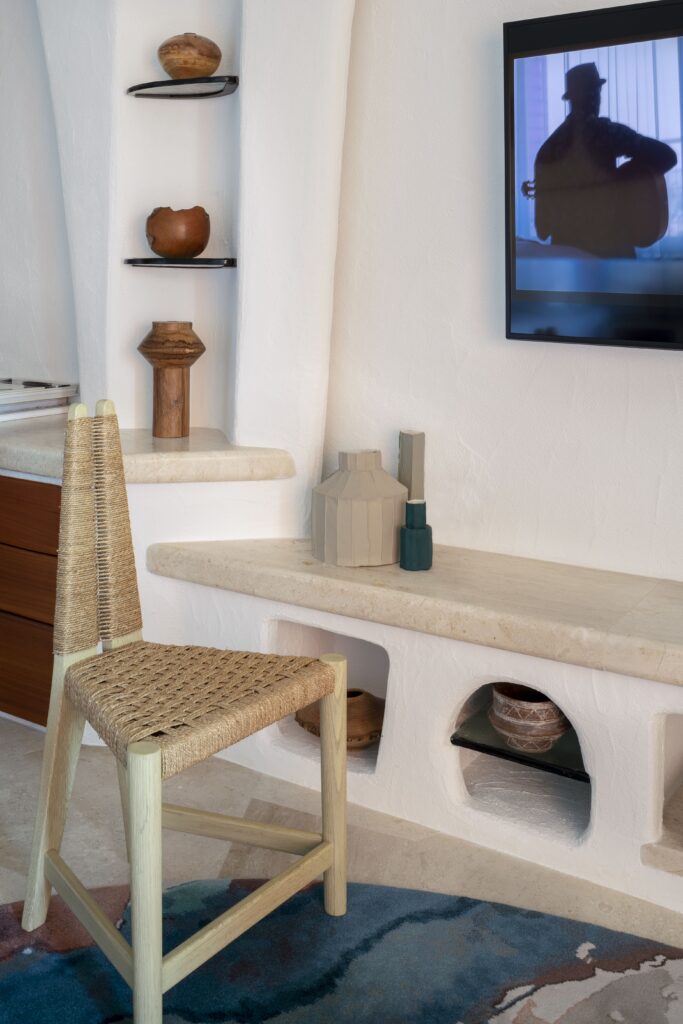
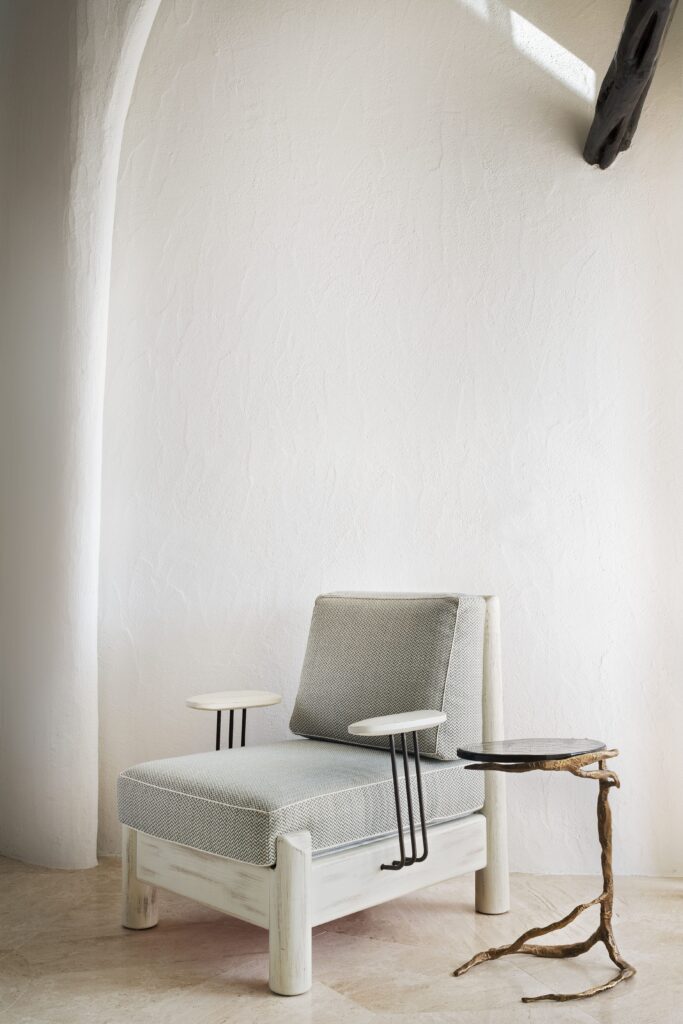
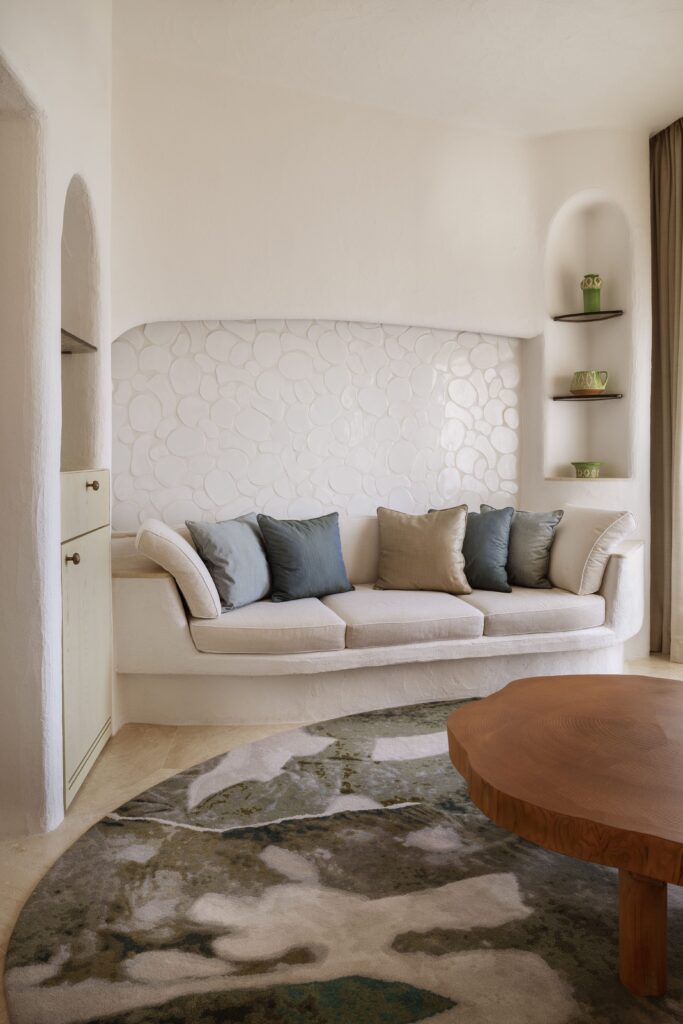
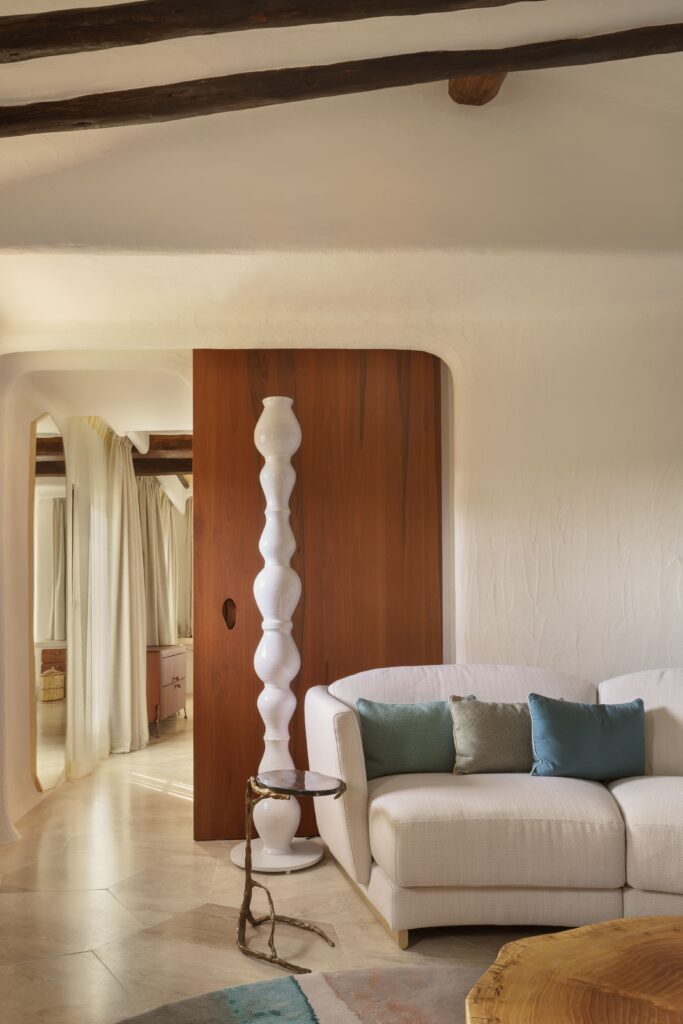
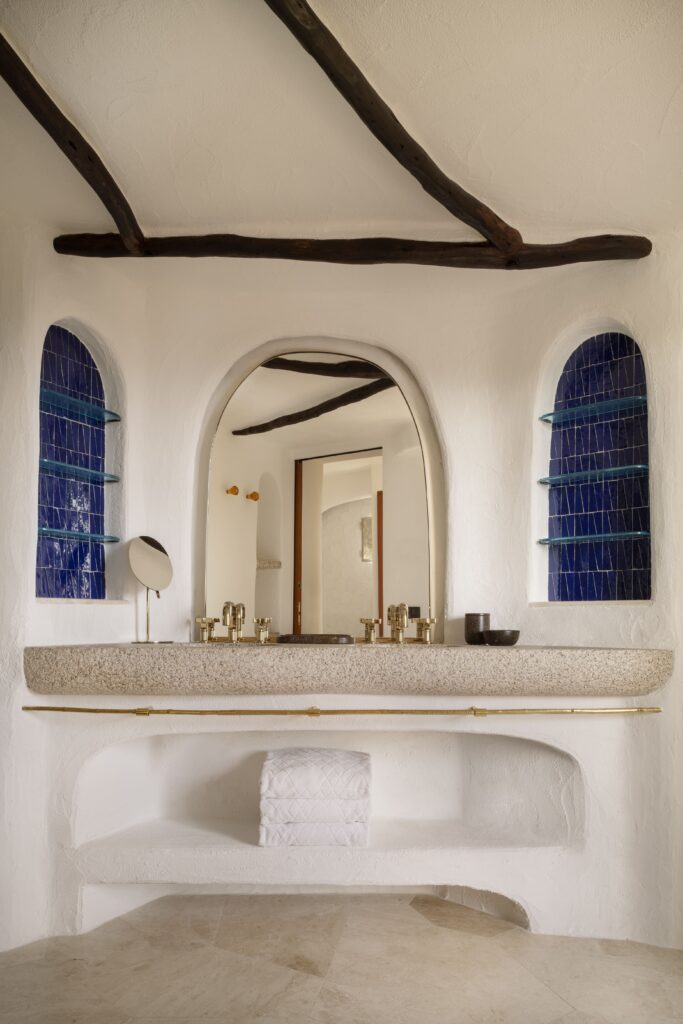
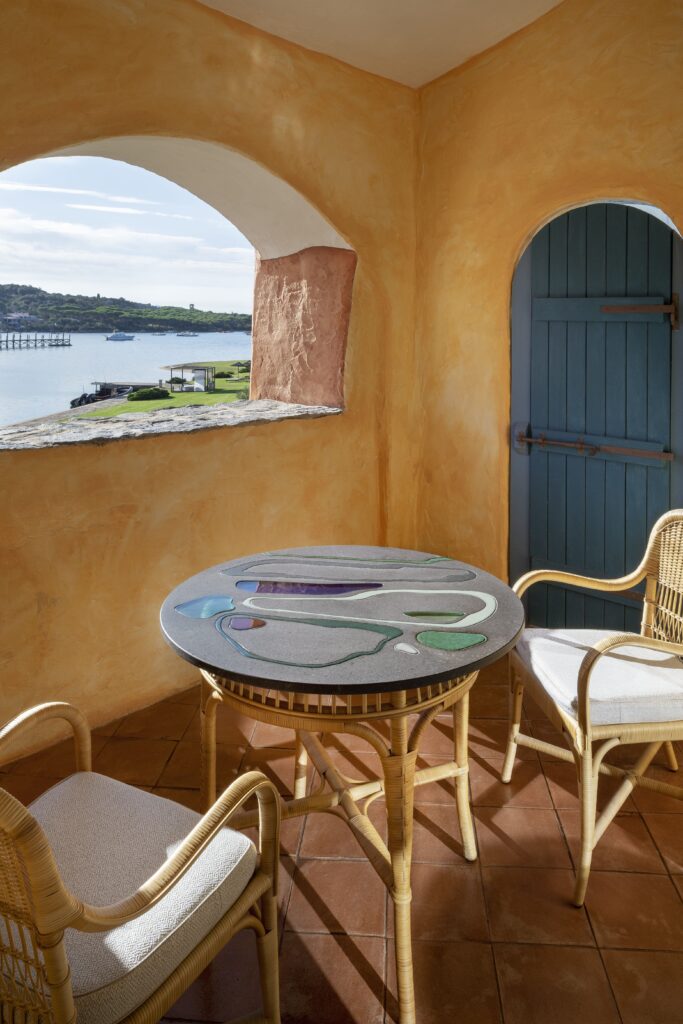
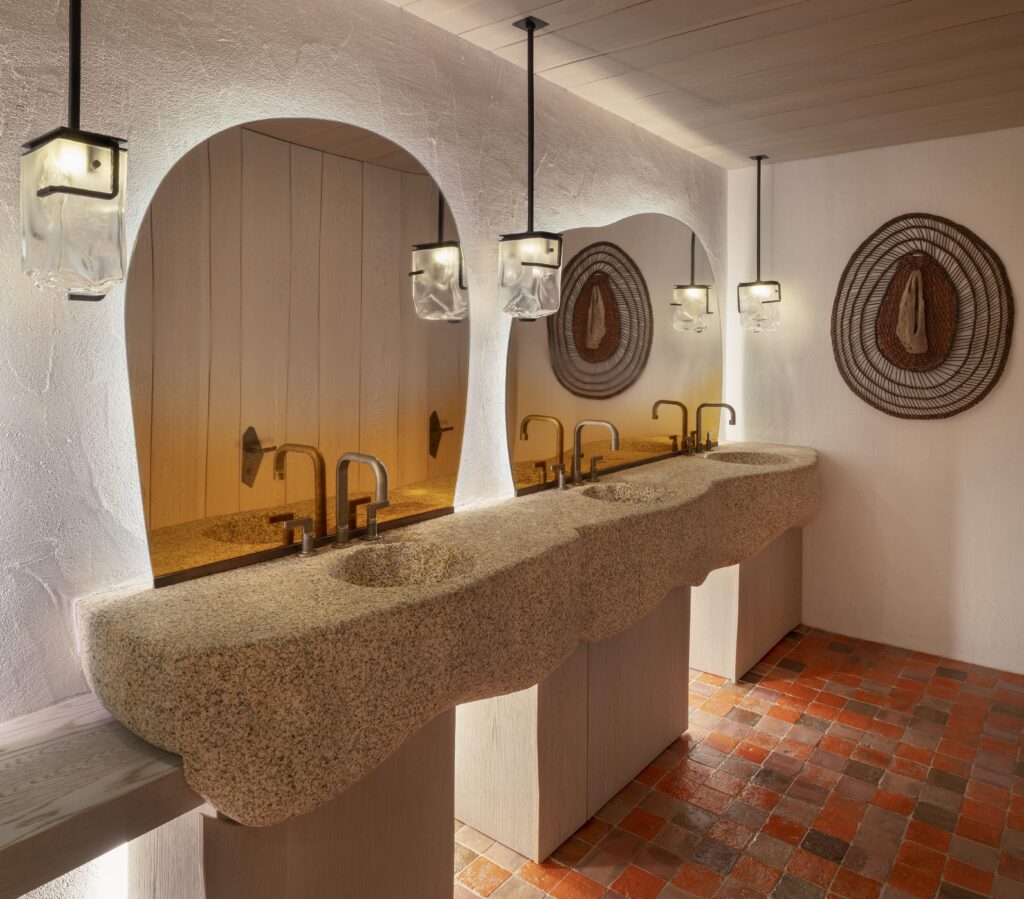
Restaurants
Le Grand
It is the gastronomic and emblematic restaurant of Cala di Volpe. Though the spirit of the menu has not changed – historical dishes are served that customers love to feast on – everything has been redesigned to offer a warmer and more personal experience.
- The large room, in one piece, lacked intimacy. It was necessary to give it a visual rhythm and personality without detracting from the perspective and view from outside. Distinct spaces were thus created thanks to the subtle play of light and thin canes falling in light curtains.
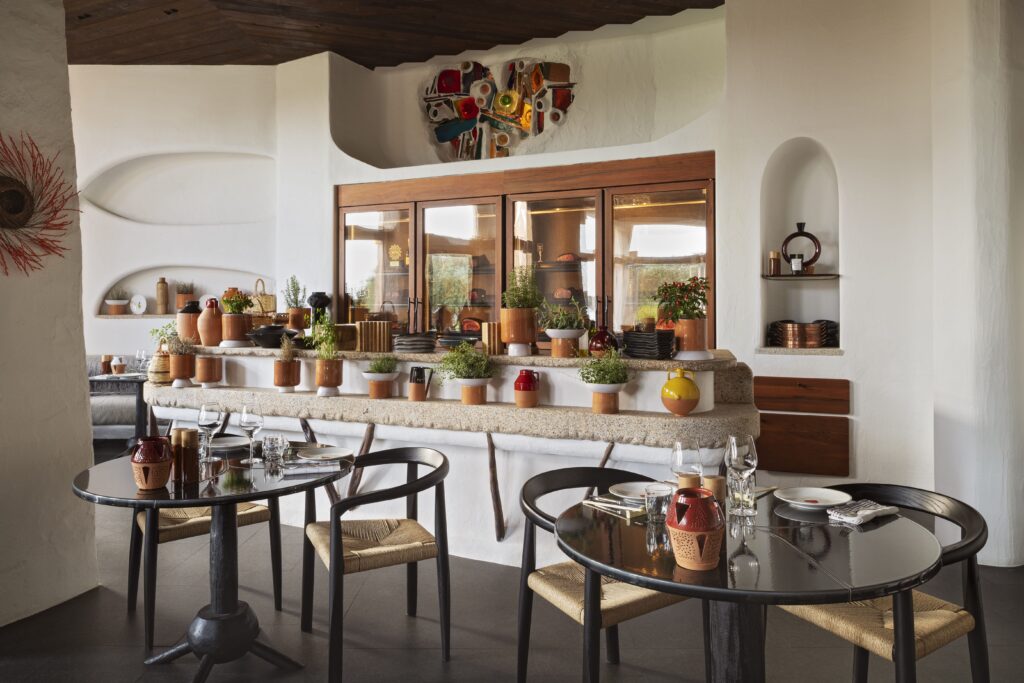
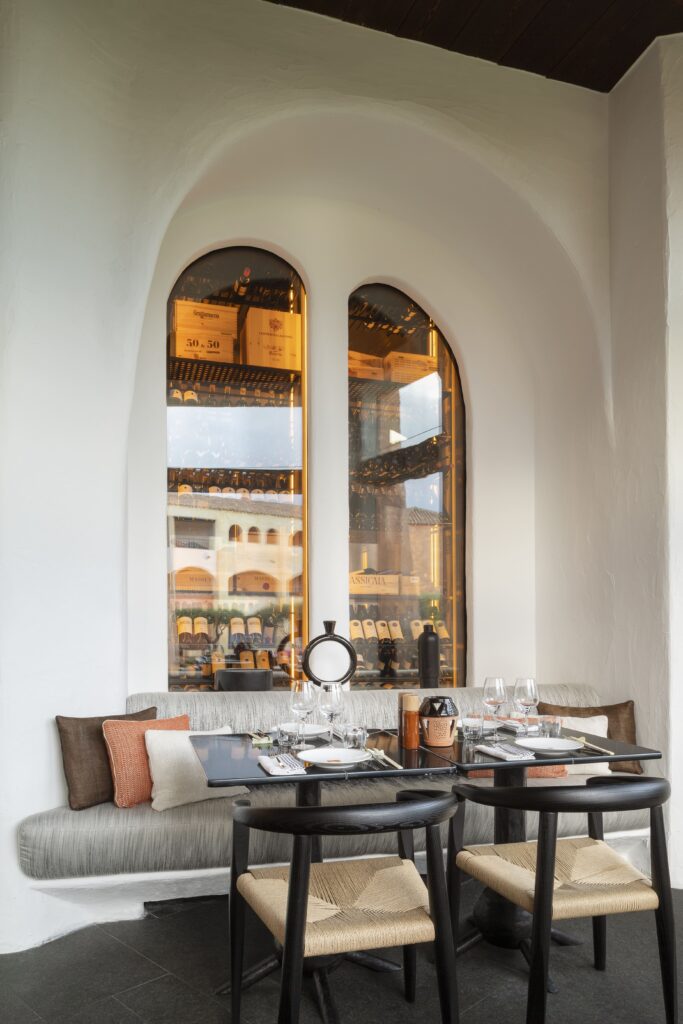
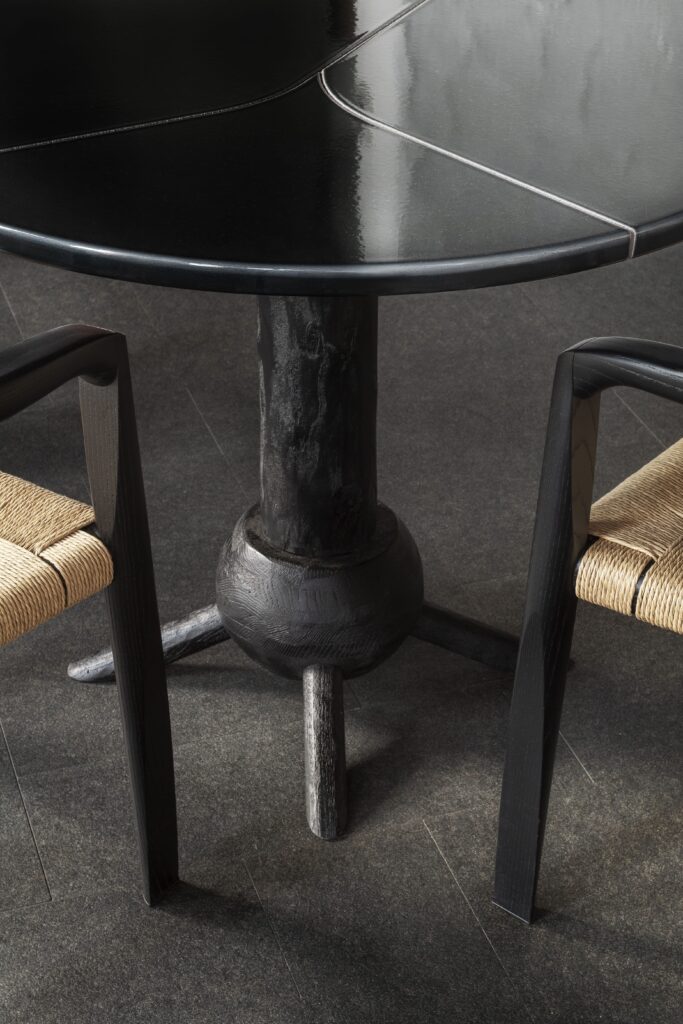
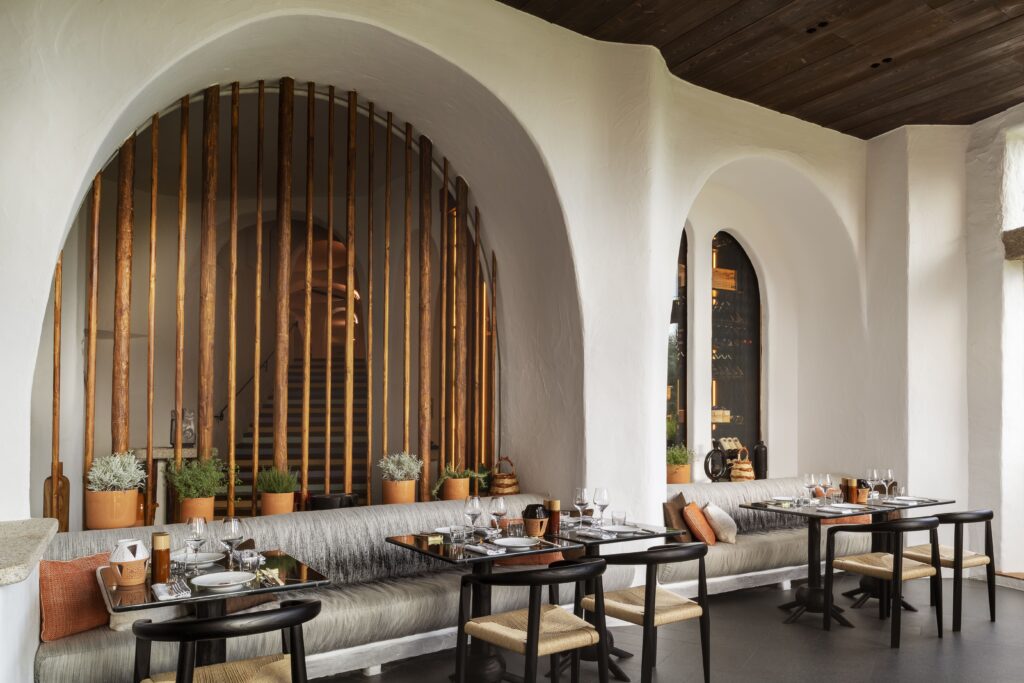
The Atrium Bar
In the extension of the lobby when looking towards the bay, it is a key place in the hotel, a place of rest, meeting and exchange, and one of the most representative elements of the architectural gesture of Jacques Couëlle. In the rotunda, the Atrium Bar is a covered terrace. The solid graphic arches and pillars that delimit it create multiple frames and points of view that are renewed every hour. A feast of images for Instagram.
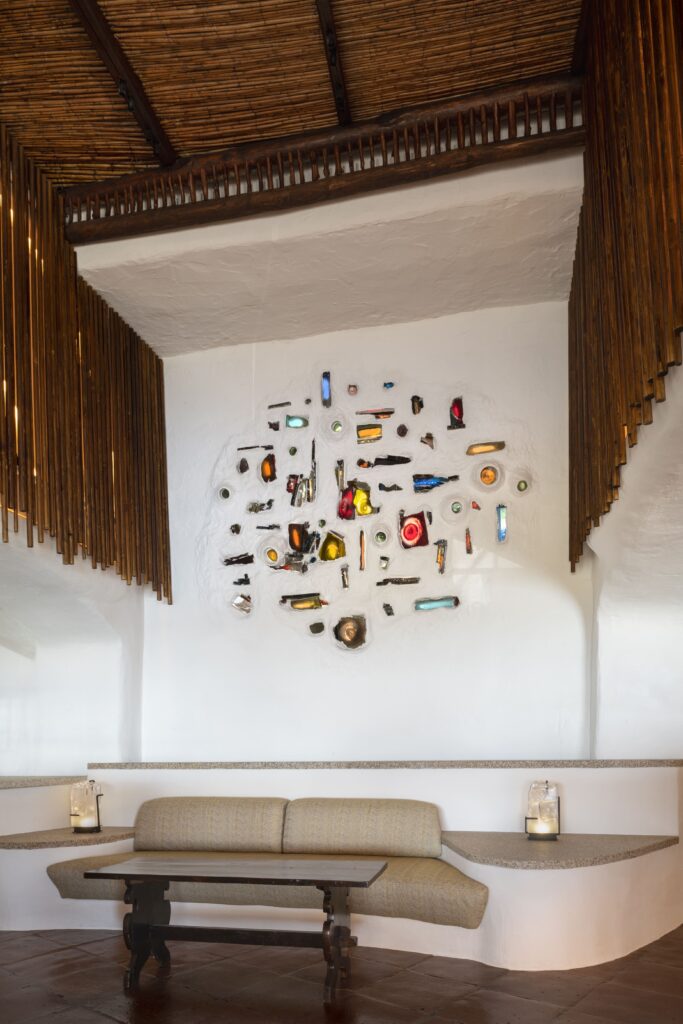
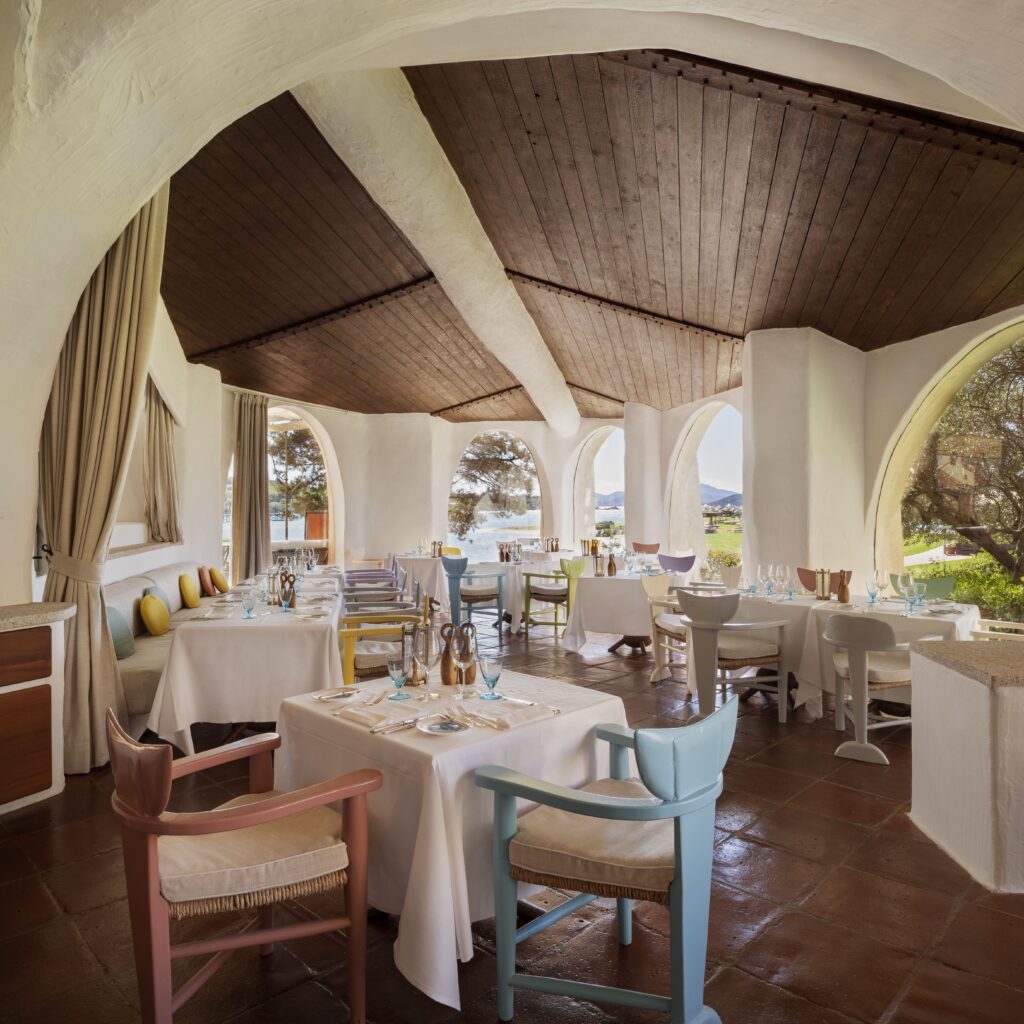
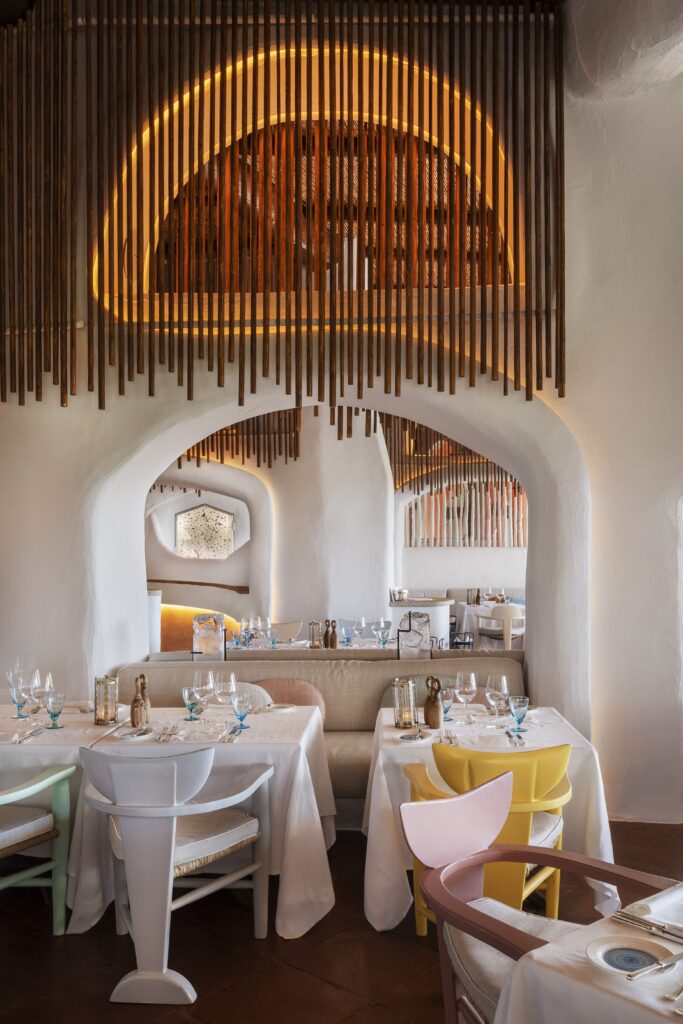
- Pillars and arches have been coated in dark ochre. In the evening light, the structure turns red. To emphasise the graphics, a net of light has been fitted and runs at the foot of the pillars.
- At the entrance, a beautiful masonry bench is at ease under the spectacular composition of coloured glass imagined by Jacques Couëlle.
- The masonry structure and the cane and wood ceiling, creating such a specific atmosphere, have been preserved, highlighted by a lot of work done on the light. The rounded interior of the high half- moon openings is now delimited by warm lighting, just like, vertically, certain pillars. Optically an architecture of light is superimposed.
- The terracotta floor, with large uneven tiles, has been restored: shiny, leather-coloured, it gives a reassuring and welcoming base to the whole.
- The original bentwood furniture painted in both bright and soft colours has been restored. The blue, pink and yellow of the backs and legs play with the straw of the seats. They appear also as cushions for the benches arranged back-to-back under the arches.
- As a continuation of the restaurant, under its stretched canvas, the terrace serves meals and is equipped with new black wood furniture that echoes the huge pontoon so emblematic of Cala di Volpe, reaching out towards the sea.
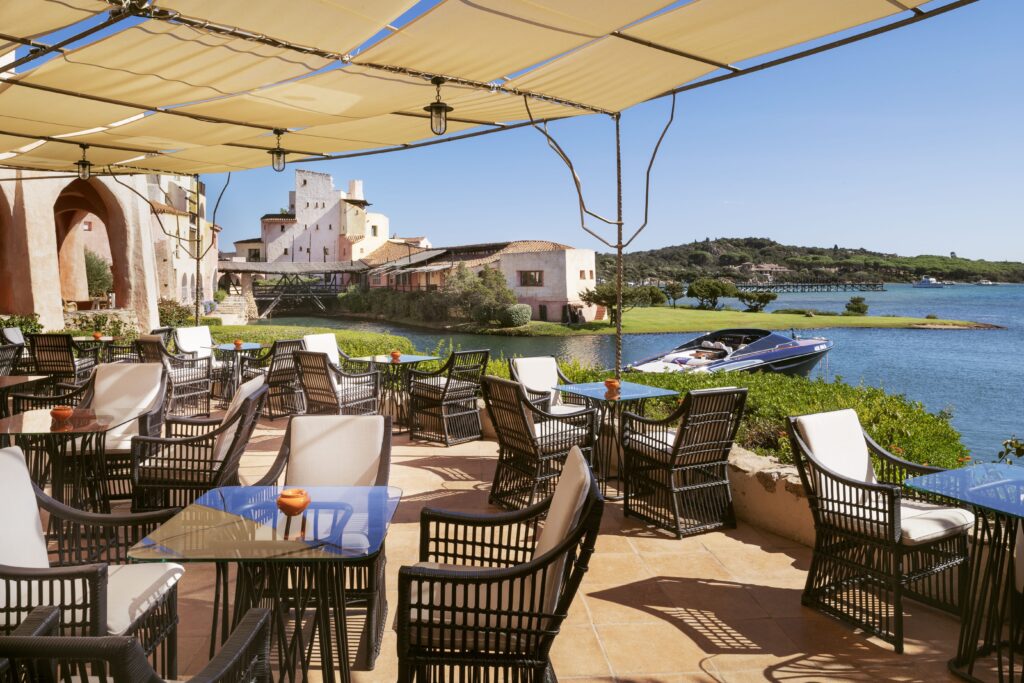
Pool Bar and Restaurant
In Cala di Volpe you can spend your day at the swimming pool. The hotel offers two catering outlets which have been fitted out in harmony with the new spirit of the place.
Hotel Cala di Volpe: Costa Smeralda, Porto Cervo, Italy, T +39 0789 976111

